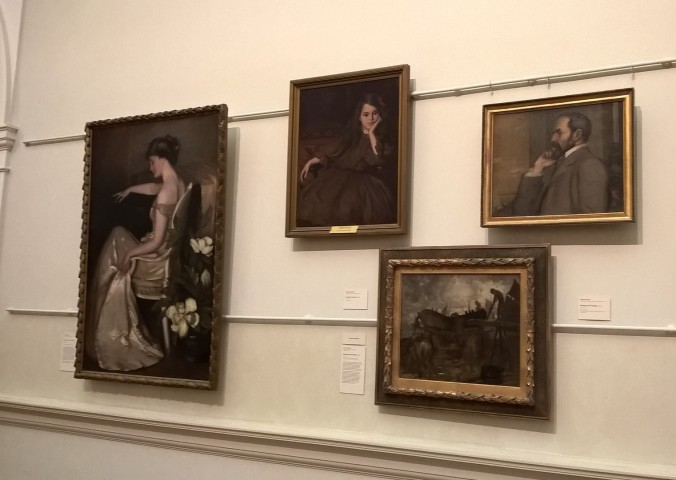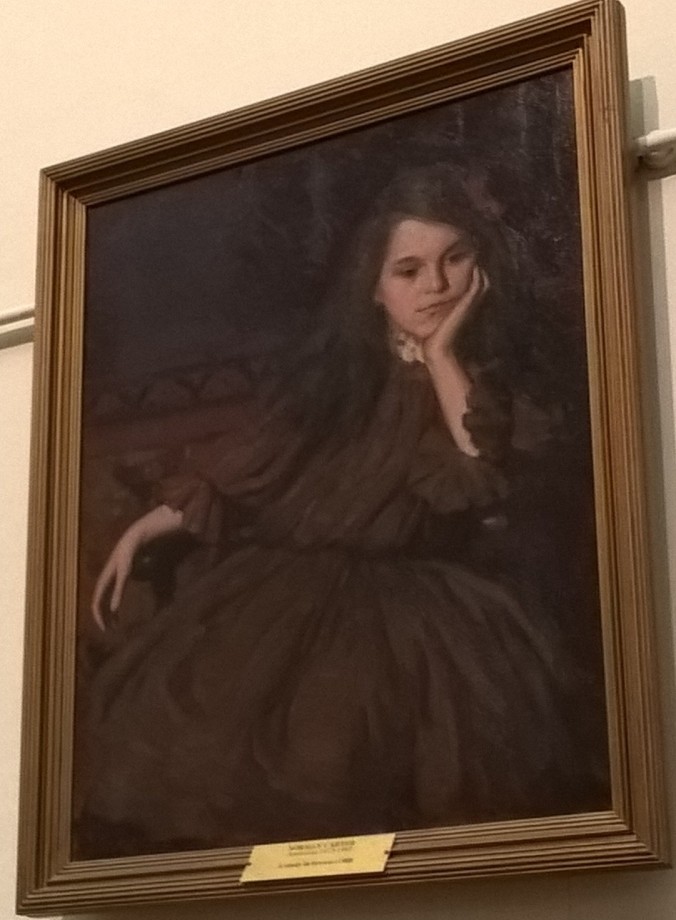Only a fraction of what the NSW Art Gallery owns is on display at any one time. The remainder of its collection is held in storage at a specially designed warehouse in an industrial area a good half hour drive away from Sydney’s centre. By pre-arrangement, any member of the public can ask to view one of those stored pieces.
After all our research JA and I had a pile of circumstantial evidence, but nothing that “provided any direct proof” that the sitter for Norman Carter’s Study in Brown was Lucy Elizabeth Creft. All the same, we were determined to see the painting with our own eyes.
There’s nothing glamorous about viewing artwork in storage. Designed for easy access by trucks, the ample car park and modern building looked more like the supermarket warehouses I was familiar with from my working years, rather than a sanctuary for precious art. The complex is not usually visited by the public, and the car park was deserted, save for a few staff vehicles. JA and I arrived in separate cars. After finding the nondescript entrance, we went through the standard security check. Then after a brief wait we were ushered into a cement-floored hallway, a solid wall on one side, and a wall of metal mesh on the other.
And there, hanging about eye-height on a section of the metal mesh, all alone and awaiting our inspection, was Study in Brown. It was bigger than we’d expected, 3′ x 2.5′ in the old scale (91x75cm), and the oil paint gave off a luminescence that is not obvious in the digital image. Here was our dark-haired, fair-skinned twelve-year-old schoolgirl, practically in the flesh. Seeing her like that, we were even more convinced this was the painting that had been described to each of us by my aunt and JA’s grandmother.
To our knowledge, “grandmother” was the last surviving person who had seen the portrait many times, and knew for certain that the sitter was Lucy. She had the story from her father, who was married to Lucy up till her death in tragic circumstances, aged only thirty-one. Despite his re-marriage, he honoured Lucy’s memory and took his daughter to visit the portrait very frequently. When she was older, she continued the pilgrimage for herself.
Seeing the painting, JA and I agreed we’d done as much groundwork as we could think of. It was time to ask grandmother if she would make the eight hour drive to Sydney, and tell us whether or not this was the portrait.
I wasn’t there the day that JA took her grandmother to the storage facility. I wish I had been. “There was 100% acceptance,” JA told me. “It was like she was re-united. She barely took her eyes off her.”
And that, my friends – as if I really needed any convincing by then – was good enough word for me. I too, have become very attached to Lucy, and in a strange way, also experience this feeling of re-connection to a lost soul whose DNA I share.
And although it is not the irrefutable proof that would be needed to meet the requirement for art world provenance, the curator I have been liaising with has advised this story will be kept on Study in Brown‘s file for background information.
It’s been many decades since the painting was on permanent display. Recently, that curator has revisited early 20th century Australian art, and for a short time, Study in Brown is once again on view – right where my Aunty Myra told me to look in the first place.
And Norman Carter is once more re-united with his contemporaries such as Rupert Bunny.
The below snaps are from my phone. They don’t show that the painting has been restored, and now it truly shows its depth and the exquisite colouring of the complexion. Nor can you see just how red is the bow in her hair, which I quite obscured in the close-up photo. You can take another look at the digital image here.
I have always wondered about the splotch of white frill at her neck. The main cause of Lucy’s death was a thyroid goitre, and I’ll never know whether this frilly piece was for decoration, or some type of choker to hide an already growing protrusion.
Whatever the case, it was wonderful to see the painting back on display, with both the portrait and frame restored and glowing. It was quite an emotional moment, and I feel very fortunate to have been able to see her for myself. Much as the Art Gallery’s digital image is better than my mobile phone snaps, nothing compares to seeing the real thing.

Exhibition of early 20th century Australian art on display at the Art Gallery of NSW, November 2018

Study in Brown, Norman Carter, 1908. On display at Art Gallery of NSW, November 2018
A final footnote to this story is that in 1962, a year before his death, Norman Carter was interviewed by Hazel de Berg; an oral history pioneer. Here we have the voice of the man, then in his late 80s, recollecting his early art studies, his approach to portrait painting, and his stained glass work. It runs for about twenty minutes and you can listen here (click “I accept” for the licence agreement). Once again this valuable piece of history is made available to us through the National Library of Australia’s digitisation project; and locatable through Trove.
And that, my friends, is the final part of our search to re-unite my great-aunt, Lucy Elizabeth Creft, with her rightful place in Australian art history.
I’m almost speechless! What a long journey with a heartwarming ending. I love the portrait! I’m also awed by the amount of time and detail you went through before finding the real thing.
My habit in art museums is to root myself in front of a few choice paintings that capture my attention, and let them sink in. This portrait of Lucy would be just that kind of portrait. So human, young, and self-possessed. Thanks, Gwen! 🙂
LikeLiked by 1 person
Thanks so much Elouise. I’m trying to weave this story into the manuscript I am writing. The original character was Lucy’s mother, Louisa, but perhaps Lucy, and to a lesser extent her sister Florence, actually carry the story.
LikeLiked by 1 person
Thank you Gwen,
I’m catching up been, a bit iffy lately.
Well it’s the outcome I fully expected, it’s a beautiful portrait,
My friend Ira, you may have noticed a comment from her occasionally, she doesn’t blog but she reads my stuff; she’ is a volunteer guide at the gallery, next time we have a drink I’ll make sure that she knows the story that you’ve taken forever to tell, and I’ve taken forever to read 😈
Happy New Year Gwen 😀
LikeLiked by 1 person
I was worrying about you. I hope you’re feeling brighter.
How interesting you have a colleague at the gallery. I’d love you to share the story.
I’ve been asked to do a talk on these blogs posts (well Norman Carter and the search, etc) at the local U3A sometime next year when they have a hole in the schedule.
I haven’t been working on my manuscript all through December, too much silly season. But when I return to it, I’m going to cast a critical eye over to make sure that Lucy is well highlighted. People seemed to respond well to her (although it didn’t end well for her, dying so young in tragic circumstances).
LikeLike
Such a great end to a wonderful piece of investigative journalism, Gwen. I can’t wait to read more about Lucy. Hope the writing is going well.
LikeLiked by 1 person
Thank you Jolandi. I am trying to bring Lucy to life in the writing, which has stalled for most of December on account of too much partying! The silly season really started early this year.
LikeLike
Fabulous result Gwen and quite emotional, such a shame you couldn’t have been there at the viewing.
(Just reposting this bit of a previous comment in case lost at end of other thread . . .
. . . Well, I think they must add information about the sitter now. Actually, I think added to the ticket whenever it is on public view with a ‘thought to be Lucy Elizabeth Creft’. That is the kind of detail that ordinary people are interested in and if there was an indication of where to find further information they could point to your Blog posts.
LikeLiked by 1 person
I got to see it with JA, but not the second time when she brought her grandmother. It would have been wonderful to see her reaction first-hand.
I’ve noted your suggestion in my diary for next year and when “my” curator returns at the end of January I will phone and have a chat with her. Meantime, apparently “Study in Brown” has already been taken back off public exhibition again. She did warn me it would only be up for a short time, so lucky I went into the art gallery when I did!
LikeLiked by 1 person
Yes, it’s surprising how much art is in storage all round the world at any given time. I think here in the UK there’s a policy of rotating works these days and sending national treasures out to small regional museums and galleries. So glad you got to see ‘Study in Brown’ in real life.
LikeLiked by 1 person
I went the other day to check for myself. There is a display from the Hermitage and a couple of pieces have migrated from their special exhibition area and taken up the space occupied by Study in Brown and Rupert Bunny’s, Hans Heyson’s works. I forget the name of the artist but apparently he originally trained in Melbourne. So poor old Lucy is once again consigned to the “sin bin”. And yet, there are so many other pieces in that hall which are permanently displayed. The art gallery has approval to expand, so it will be interesting to see what they bring out of storage then.
LikeLiked by 1 person
Super story!!
LikeLiked by 1 person
Thanks JoJo. Now I’m trying to weave it into the current manuscript. xx
LikeLike
Great work, Gwen. What a pity you missed grandmother’s visit
LikeLiked by 1 person
It would have been wonderful to have seen her reaction first hand.
LikeLiked by 1 person
Beautiful! A lot of work but worth it. Lovely Lucy.
LikeLiked by 1 person
Thank you Don. I’m trying to bring her to life in my current manuscript attempt.
LikeLiked by 1 person
Excellent outcome – and good that the painting has been exhibited once more.
LikeLiked by 1 person
I’m glad she had her moment in the sun again. I’ve heard it’s off display again.
LikeLiked by 1 person
What a wonderful, but sad story. A beautiful young woman almost lost in history will now live on.
LikeLiked by 1 person
I am glad to have discovered this, and other stories of Lucy. I have spoken to my older cousins and none of them had any knowledge of her existence.
LikeLiked by 1 person
Beautiful story. Its good to know where we came from x
LikeLiked by 1 person
Thank you Glenda. That is so true!
LikeLike
Lovely ending!
LikeLike
Glad you like it!
LikeLike